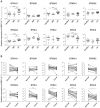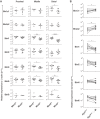Altered expression of Butyrophilin (BTN) and BTN-like (BTNL) genes in intestinal inflammation and colon cancer
- PMID: 27957327
- PMCID: PMC4879465
- DOI: 10.1002/iid3.105
Altered expression of Butyrophilin (BTN) and BTN-like (BTNL) genes in intestinal inflammation and colon cancer
Abstract
Several Butyrophilin (BTN) and Btn-like (BTNL) molecules control T lymphocyte responses, and are genetically associated with inflammatory disorders and cancer. In this study, we present a comprehensive expression analysis of human and murine BTN and BTNL genes in conditions associated with intestinal inflammation and cancer. Using real-time PCR, expression of human BTN and BTNL genes was analyzed in samples from patients with ulcerative colitis, irritable bowel syndrome, and colon tumors. Expression of murine Btn and Btnl genes was examined in mouse models of spontaneous colitis (Muc2-/-) and intestinal tumorigenesis (ApcMin/+). Our analysis indicates a strong association of several of the human genes with ulcerative colitis and colon cancer; while especially BTN1A1, BTN2A2, BTN3A3, and BTNL8 were significantly altered in inflammation, colonic tumors exhibited significantly decreased levels of BTNL2, BTNL3, BTNL8, and BTNL9 as compared to unaffected tissue. Colonic inflammation in Muc2-/- mice significantly down-regulated the expression of particularly Btnl1, Btnl4, and Btnl6 mRNA, and intestinal polyps derived from ApcMin/+ mice displayed altered levels of Btn1a1, Btn2a2, and Btnl1 transcripts. Thus, our data present an association of BTN and BTNL genes with intestinal inflammation and cancer and represent a valuable resource for further studies of this gene family.
Keywords: Butyrophilin (Btn)‐like (Btnl); colon cancer; immune regulation; intestinal inflammation; irritable bowel syndrome (IBS); ulcerative colitis (UC).
Figures



Similar articles
-
The ontogeny of Butyrophilin-like (Btnl) 1 and Btnl6 in murine small intestine.Sci Rep. 2016 Aug 16;6:31524. doi: 10.1038/srep31524. Sci Rep. 2016. PMID: 27528202 Free PMC article.
-
Heteromeric interactions regulate butyrophilin (BTN) and BTN-like molecules governing γδ T cell biology.Proc Natl Acad Sci U S A. 2018 Jan 30;115(5):1039-1044. doi: 10.1073/pnas.1701237115. Epub 2018 Jan 16. Proc Natl Acad Sci U S A. 2018. PMID: 29339503 Free PMC article.
-
New Insights Into the Regulation of γδ T Cells by BTN3A and Other BTN/BTNL in Tumor Immunity.Front Immunol. 2018 Jul 11;9:1601. doi: 10.3389/fimmu.2018.01601. eCollection 2018. Front Immunol. 2018. PMID: 30050536 Free PMC article. Review.
-
BTN1A1, the mammary gland butyrophilin, and BTN2A2 are both inhibitors of T cell activation.J Immunol. 2010 Apr 1;184(7):3514-25. doi: 10.4049/jimmunol.0900416. Epub 2010 Mar 5. J Immunol. 2010. PMID: 20208008
-
Butyrophilins: Dynamic Regulators of Protective T Cell Immunity in Cancer.Int J Mol Sci. 2023 May 13;24(10):8722. doi: 10.3390/ijms24108722. Int J Mol Sci. 2023. PMID: 37240071 Free PMC article. Review.
Cited by
-
Effect of a Semi-Purified Oligosaccharide-Enriched Fraction from Caprine Milk on Barrier Integrity and Mucin Production of Co-Culture Models of the Small and Large Intestinal Epithelium.Nutrients. 2016 May 6;8(5):267. doi: 10.3390/nu8050267. Nutrients. 2016. PMID: 27164134 Free PMC article.
-
BTNL2 promotes colitis-associated tumorigenesis in mice by regulating IL-22 production.EMBO Rep. 2023 Mar 6;24(3):e56034. doi: 10.15252/embr.202256034. Epub 2023 Jan 11. EMBO Rep. 2023. PMID: 36629012 Free PMC article.
-
Genome-wide DNA Methylation in Treatment-naïve Ulcerative Colitis.J Crohns Colitis. 2018 Nov 15;12(11):1338-1347. doi: 10.1093/ecco-jcc/jjy117. J Crohns Colitis. 2018. PMID: 30137272 Free PMC article.
-
A novel disulfidptosis-related immune checkpoint genes signature: forecasting the prognosis of hepatocellular carcinoma.J Cancer Res Clin Oncol. 2023 Nov;149(14):12843-12854. doi: 10.1007/s00432-023-05076-4. Epub 2023 Jul 18. J Cancer Res Clin Oncol. 2023. PMID: 37462769 Free PMC article.
-
Prediction of Disordered Regions and Their Roles in the Anti-Pathogenic and Immunomodulatory Functions of Butyrophilins.Molecules. 2018 Feb 4;23(2):328. doi: 10.3390/molecules23020328. Molecules. 2018. PMID: 29401697 Free PMC article.
References
-
- Arnett, H. A. , Escobar S. S., Gonzalez‐Suarez E., Budelsky A. L., Steffen L. A., Boiani N., Zhang M., Siu G., Brewer A. W., and Viney J. L.. 2007. BTNL2, a butyrophilin/B7‐like molecule, is a negative costimulatory molecule modulated in intestinal inflammation. J. Immunol. 178(3):1523–1533. - PubMed
-
- Yamazaki, T. , Goya I., Graf D., Craig S., Martin‐Orozco N., and Dong C.. 2010. A butyrophilin family member critically inhibits T cell activation. J. Immunol. 185(10):5907–5914. - PubMed
-
- Chapoval, A. I. , Smithson G., Brunick L., Mesri M., Boldog F. L., Andrew D., Khramtsov N. V., Feshchenko E. A., Starling G. C., and Mezes P. S.. 2013. BTNL8, a butyrophilin‐like molecule that costimulates the primary immune response. Mol. Immunol. 56(4):819–828. - PubMed
Publication types
MeSH terms
Substances
LinkOut - more resources
Full Text Sources
Other Literature Sources
Molecular Biology Databases
Miscellaneous

